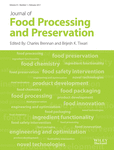Oxidative Stability of Cooked Pork Patties Incorporated with Clitoria ternatea Extract (Blue Pea Flower Petal) During Refrigerated Storage
Abstract
This experiment examined the efficacy of Clitoria ternatea extract (CTE) in curtailing lipid and protein oxidation taking place in cooked pork patties during refrigerator storage. The pork meats mixed with CTE (0.02–0.16% w/w) were cooked and stored in a refrigerator (4C) for 12 days. The results showed that the cooked pork patties with added CTE showed high radical scavenging activity. Addition of CTE (0.02–0.16% w/w) significantly reduced the level of thiobarbituric acid-reactive substances (TBARS). Protein oxidation was seen to involve a decrease in carbonyl content and a concomitant increase in protein thiol levels in cooked pork patties containing CTE during storage. In addition, the pork patties together with CTE had a lower Hunter color L*- and higher a*-value than control. CTE (0.08–0.16%) had the potential to inhibit oxidative rancidity as well as synthetic antioxidant (0.02% BHT). The findings indicate that CTE has great potential as a natural antioxidant for producing functionally improved meat products.
Practical Applications
Ready-to-eat products are highly prone to oxidative deterioration. Synthetic antioxidants have been used to control oxidative damage. In recent years, natural antioxidants have increasingly replaced artificial preservatives in food products. This work has proven the practical value of blue pea extract in ready-to-eat food flavoring as it is proved to have good antioxidant properties. These results demonstrate the potential combined use of blue pea extract to the meat industry in the development of novel healthy meat products with improved shelf life of stored products without affecting other qualities and hence making the consumer healthier. This research explores the effects of natural antioxidants on quality changes of cooked pork patties during refrigerated storage.




